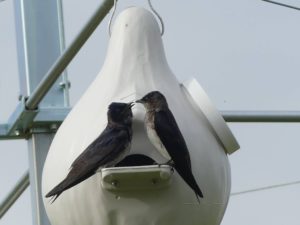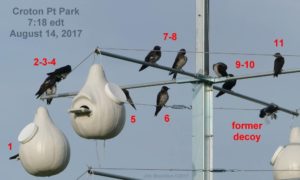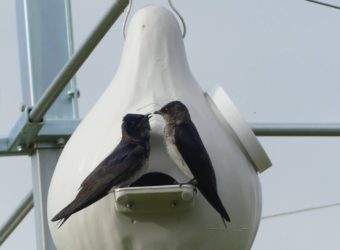Purple Martins at Croton Point!

Photo: Rob Armanini
[Spring 2018 update below]
In late March 2017, Charlie Roberto noted that he had seen Purple Martins last spring just a few miles north of Croton Point, in Putnam County along the Hudson. He added, “Croton Point is a perfect place for a colony…but we would have to get it done by the end of April to have a chance for nesting this year.” Challenge accepted!
Saw Mill River Audubon contacted Rob Armanini, owner of the Feed the Birds store in Croton to see about martin tower pricing. Rob immediately offered us wholesale pricing and then went even further than that, underwriting half the cost. (Thanks again, Rob!)
SMRA also contacted John Baker, (then) Director of Conservation for Westchester County Parks, who linked us with the Westchester Parks Foundation for more funding support.
Croton Point Park Naturalist John Phillips handled the Croton Point Park permissions and went even further, arranging for some park staff to dig the hole, and erect the tower. Meanwhile, John also assembled the many, many parts that go into a purple martin nesting tower.
 By April 19, Croton Point Park had a brand new Purple Martin nesting tower. Now for some martins.
By April 19, Croton Point Park had a brand new Purple Martin nesting tower. Now for some martins.
There’s a wealth of advice online about Purple Martin colonies including an active discussion forum at the Purple Martin Conservation Association’s web site (www.purplemartin.org.) All these experienced martin watchers agree that the best way to attract martins to a new colony was (1) have a purple martin plastic decoy at the top of the tower, and (2) play recordings of a purple martin dawn song — when else? — at dawn. Purple Martins are highly social and will show up where they think other martins already are.

Fake Martin
John Phillips took care of getting the plastic Purple Martin decoy installed. This plastic decoy came with our Purple Martin structure but lacked a good attachment scheme. No matter. Some duct tape did the trick. (We shall leave nameless those few birders that, briefly, eBirded the plastic martin.)
As for the dawn songs, there’s an .mp3 audio file for that. We put up a notice on Facebook for some volunteers to come at dawn and play recordings. Jessica T. stepped up for several mornings of song playing, some others did as well. We persisted. And a month went by with no Purple Martins.
May 22, 2017 Saw Mill River Audubon’s regular 4th Monday morning walk at Croton Point saw a martin! A lone Purple Martin — perhaps a scout for a new colony — was flying around the main parking lot, singing and trying to enter the emergency siren structure. Just down the road from our sparkling new nesting structure.
 This one martin stuck around for two more weeks, finally making its way over the nesting tower.
This one martin stuck around for two more weeks, finally making its way over the nesting tower.

It kept adding its voice to our dawn chorus playbacks and then, at last, FOUR Purple Martins were seen on June 8, sitting and singing in the right place, on the new nesting tower.
 A week later, June 15, we had five martins and a week later, reports of up to 8 martins! .
A week later, June 15, we had five martins and a week later, reports of up to 8 martins! .
Our Monday walk on June 26 stopped to watch the martins. We saw an adult pair, male and female, carrying nesting materials into one of the nesting gourds.

If nesting is successful, this will be the only known Purple Martin colony in Westchester County. (A small colony was in the Rye area, along the Long Island Sound, but apparently lost its housing during Hurricane Sandy in 2012.)
Here’s another look at real Purple Martins on the tower either side of the decoy martin.
Photo: Valerie Heemstra.

August 2017 Update
Despite several people observing the nesting tower, we are uncertain whether nesting was successful this year and we will check the nesting gourds before winter storage. However, by the middle of August, as many as 11 martins were seen at once, as shown in this photo below by Jim Bourdon. (The Martin decoy was also slipping its duct tape bounds at that point and later retrieved to be reattached next spring.)

September 2017 Update: What was in the Gourds?
Max count of five Martins — three adult males among them — are being seen around the nesting structure as of May 18, 2018 with one pair, at least, apparently establishing a nest in one gourd.
